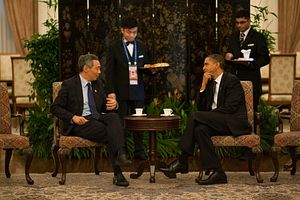This week, Singapore Prime Minister Lee Hsien Loong will visit the United States as the two countries commemorate the 50th anniversary of their diplomatic relations. Lee’s visit will feature a rare state dinner in his honor hosted by President Barack Obama, making him just the fifth Asian leader to have been granted such a privilege in the Obama White House. But more importantly, both sides will also look to advance their strategic partnership even further, with significance not only for them but also the region as well.
As I noted in a piece this week for Singapore newspaper TODAY, Singapore has been an indispensable partner for the United States (See: “US-Singapore Ties Poised to Hit New Highs”). Economically, the city-state has long enjoyed the mammoth share of U.S. foreign direct investment to Southeast Asia and was instrumental in urging Washington to join the P-4 trading group that eventually evolved into what is now termed the “U.S.-led” Trans-Pacific Partnership (TPP). And security-wise, Singapore has been a key point for U.S. access, serving as home to a U.S. Navy logistics command unit that coordinates operations and exercises, as well as host to littoral combat ships and P-8 Poseidon aircraft (See: “US, Singapore Ink New Defense Pact”).
U.S. and Singapore officials both emphasize that the visit is partly designed to acknowledge the importance of this relationship. But for the Obama administration, the visit will also provide an opportunity to expand the various dimensions of the bilateral relationship, advance what both countries can do together in the region, and promote some of the remaining agenda items for Southeast Asia that Obama would like to tick off before his second term expires and a new president takes office next January.
First, on the bilateral relationship itself, officials on both sides say there are a whole host of deliverables covering economics, security, science and technology as well as people-to-people relations. These deliverables are expected to add both breadth and depth to the U.S.-Singapore strategic partnership, which was officially declared by the Obama administration in 2012 (See: “US-Singapore Ties: Solid Base for an Uncertain Future”).
Second, there will also be announcements about some new things that the United States and Singapore will be looking to do together in the region. The two counties already do a fair bit, with one important example on the economic side being the Third Country Training Program (TCTP) where they have jointly extended technical assistance to developing countries, with a focus on those in the lower Mekong subregion. During the visit, it will be interesting to see what the two countries will be able to announce regarding collaboration on U.S.-ASEAN Connect, an effort to coordinate U.S. economic engagement in Southeast Asia first unveiled at the U.S.-ASEAN Sunnylands Summit in February (See: “Obama Unveils New ASEAN Economic Initiative at Sunnylands Summit”).
Third and finally, the visit will also be framed as a window into some of the remaining agenda items for Southeast Asia that Obama will look to advance before leaving office. In remarks at the U.S.-ASEAN Business Council earlier this month, Ben Rhodes, one of Obama’s closest advisers, said that it would be a “springboard” into what the rest of the year will look like for U.S. Southeast Asia policy. It will certainly be an active few months. Most obviously, Obama will attend the next round of ASEAN summitry in September in Laos, where he will also become the first U.S. president to visit the country (See: “Laos in the ASEAN Spotlight: Opportunities and Challenges”). But there are also other things the administration has in mind which will be gradually rolled out as events take place, including the much-anticipated visit of Myanmar’s democracy icon and now State Counselor Aung San Suu Kyi in September.
While this visit will be a boost for U.S.-Singapore strategic partnership, like any relationship it is not free of its share of challenges, as I note in my piece for TODAY. Most obviously, as both sides try to advance their relationship, there is much uncertainty within the United States and around the world about the sustainability of the U.S. presence in the Asia-Pacific with Donald Trump’s domestic-centered, protectionist foreign policy vision and even Hillary Clinton’s backpedaling on TPP. Singapore, too, is slowly changing. As both sides work in a more contested political landscape there, U.S. engagement of a broader range of actors could lead to old differences over democracy and human rights to periodically surface. Singapore, meanwhile, will need to work harder to gain the necessary domestic political support to sustain its foreign policy alignments with a more vocal population.
Beyond the domestic context in both countries, the U.S.-Singapore strategic partnership is also operating in a more tumultuous and fragmented world, with a whole host of challenges including a dangerous Islamic State, simmering Middle East, resurgent Russia, rising China, frail Europe, and weak global economy. Confronting these threats may require the two countries to think more boldly and creatively about how to expand ties even further, be it through strengthening the architecture of their bilateral cooperation or even enhancing coordination with other like-minded states to preserve the inclusive rules-based order that they both support.
Singapore’s late founding prime minister Lee Kuan Yew once told America’s first envoy to Singapore that while his generation could prepare the way for a close relationship between the U.S. and Singapore, it would be up to the next generation to implement and realize the full import of it (See: “How Do We Remember Lee Kuan Yew?”). As his son and Singapore’s current prime minister visits the United States next week, the two countries will attempt to do just that. Even as the United States remains the indispensable nation, it needs indispensable partners like Singapore that can support U.S. engagement in the region and the world.
You can read my full piece in TODAY here.

































